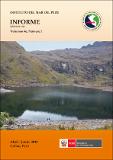Por favor, use este identificador para citar o enlazar este ítem:
https://hdl.handle.net/20.500.12958/3345| Título : | Características técnicas de poteras utilizadas en la captura del calamar gigante Dosidicus gigas (d’Orbigny) en Perú |
| Otros títulos : | Technical characteristics of jiggers used in the catch of the ju mbo flying squid Dosidicus gigas (d'Orbignyi) in Peru |
| Autor : | Alarcón Vélez, Julio Salazar Céspedes, Carlos Martín Valles, Juan Cornejo Urbina, Rodolfo Chambilla, Juan |
| Palabras clave : | Dosidicus gigas;Características técnicas;Flota artesanal peruana;Industrial extranjera;Maniobras de extracción;Diseño de las poteras |
| Fecha de publicación : | 2019 |
| Editorial : | Instituto del Mar del Perú |
| Citación : | Inf Inst Mar Perú 46(2), 2019, p.293-306 |
| Citación : | Informe IMARPE;46(2), 2019 |
| Resumen : | En
este trabajo se describen y analizan las características de diseño y dimensiones de las poteras utilizadas
por la flota artesanal peruana e industrial extranjera en función a los componentes de manufactura. Las
poteras presentan selectividad interespecífica al capturar casi exclusivamente calamares. La selectividad
intraespecífica, relacionada con la selectividad por tallas aún falta evidenciarla pero existe relación directa
entre la composición del número de ejes y coronas afines a su área de contacto y calidad de pota capturada.
Al inicio de esta pesquería en aguas peruanas, la flota extranjera utilizó poteras pequeñas con cuerpo
blando o duro y variedades de colores fluorescentes. Cuando la pota presentó cambios en su distribución
y abundancia por las condiciones ambientales, la flota industrial mediante un cambio tecnológico en las
maniobras de extracción y en el diseño de las poteras, pudo tener acceso a la captura de ejemplares con
mayor rango de talla. Se presenta un listado de acuerdo a nomenclatura, clasificación, codificación y
medición de sus componentes en función a la metodología estándar. ABSTRACT: This paper describes and analyzes the design characteristics and dimensions of the jiggers used by the Peruvian artisanal fleet and the foreign industrial one based on the manufacturing components. The jiggers show interspecific selectivity when catching almost exclusively squid. The intraspecific selectivity, related to the selectivity for sizes, has yet to be evidenced, but there is a direct relationship between the composition of the number of axes and crowns related to their contact area and the quality of the caught squid. At the beginning of this fishery in Peruvian waters, the foreign fleet used small jiggers with soft or hard body and varieties of fluorescent colors. When the squid presented changes in its distribution and abundance due to environmental conditions, the industrial fleet through a technological change in the extraction maneuvers and in the design of the jigging system, was able to have access to the catch of specimens with greater size range. A catalog by nomenclature, classification, coding, and measurement of its components according to the standard methodology is presented as a technical tool that will facilitate the management of this fishery. |
| URI : | https://hdl.handle.net/20.500.12958/3345 |
| Aparece en las colecciones: | Informe vol. 46(2) 2019 |
Ficheros en este ítem:
| Fichero | Descripción | Tamaño | Formato | |
|---|---|---|---|---|
| Informe 46-6.pdf | 21,29 MB | Adobe PDF |  Visualizar/Abrir |
Este ítem está sujeto a una licencia Creative Commons Licencia Creative Commons

